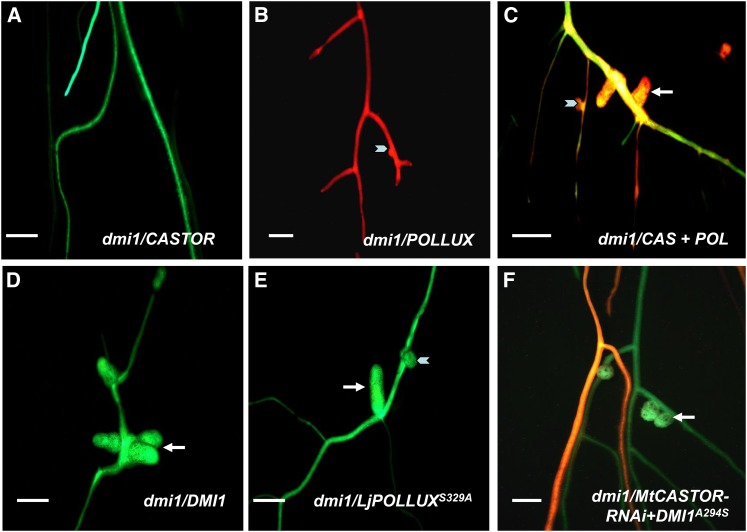Figure 3.
Rescue Assays in M. truncatula dmi1 Mutant with Lj-CASTOR, Lj-POLLUX, DMI1, and Modified Alleles.
(A) to (C) Rescue of the M. truncatula dmi1 mutation by Lj-CASTOR and Lj-POLLUX.
(A) Lj-CASTOR expressed alone does not rescue nodulation phenotype in dmi1 when inoculated with S. meliloti (pXLGD4).
(B) Lj-POLLUX expressed alone does not rescue nodulation phenotype in dmi1 mutant as only immature nodules or nodule bumps were observed in few instances.
(C) Lj-CASTOR and Lj-POLLUX together rescue dmi1 as mature functional nodules were formed.
(D) and (E) Rescue of M. truncatula dmi1 mutation by DMI1, Lj-POLLUXS329A, and DMI1A294S.
(D) DMI1 rescues nodulation phenotype in dmi1 mutant.
(E) Lj-POLLUXS329A gains function and rescues dmi1 without Lj-CASTOR.
(F) DMI1A294S does not rescue dmi1 when paired with Mt-CASTOR-RNAi.
Mature nodules are shown by white arrows; nodule bumps are shown by white arrowheads. In (C), the double transgenic roots of dmi1 line expressing Lj-CASTOR and Lj-POLLUX were colocalized for GFP (for Lj-CASTOR) and DsRED1 (for Lj-POLLUX), yielding yellow to orange fluorescent roots. In (F), the double transgenic roots of dmi1 line expressing DMI1A294S and Mt-CASTOR-RNAi were colocalized for GFP (for DMI1A294S) and DsRED1 (for Mt-CASTOR-RNAi), yielding yellow to orange fluorescent roots. In the figures, lowercase, italicized words correspond to the mutant line and uppercase, italicized words correspond to wild-type gene used for rescue assay. Bars + 5 mm.

